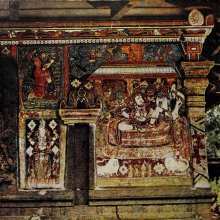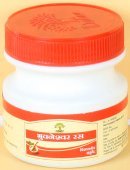Plantain: 2 definitions
Introduction:
Plantain means something in Jainism, Prakrit, biology. If you want to know the exact meaning, history, etymology or English translation of this term then check out the descriptions on this page. Add your comment or reference to a book if you want to contribute to this summary article.
Images (photo gallery)
In Jainism
General definition (in Jainism)
Source: archive.org: TrisastisalakapurusacaritraPlantain refers to a type of material used for building houses and temples, according to chapter 1.2 [ādīśvara-caritra] of Hemacandra’s 11th century Triṣaṣṭiśalākāpuruṣacaritra: an ancient Sanskrit epic poem narrating the history and legends of sixty-three illustrious persons in Jainism. Accordingly, “[...] to the east, south and north of the Lord’s birth-house, they [i.e., the Dikkumārīs] created three houses of plantain like houses of Śrī. In each one of them, they created an extensive four-room apartment adorned with a lion-throne, resembling their own palaces”.
Plantain is still used for temporary constructions in the temples and festivals.

Jainism is an Indian religion of Dharma whose doctrine revolves around harmlessness (ahimsa) towards every living being. The two major branches (Digambara and Svetambara) of Jainism stimulate self-control (or, shramana, ‘self-reliance’) and spiritual development through a path of peace for the soul to progess to the ultimate goal.
Biology (plants and animals)
Source: Google Books: CRC World Dictionary (Regional names)1) Plantain in English is the name of a plant defined with Plantago lanceolata in various botanical sources. This page contains potential references in Ayurveda, modern medicine, and other folk traditions or local practices It has the synonym Plantago lanceolata L. var. lanuginosa Bastard (among others).
2) Plantain is also identified with Plantago major It has the synonym Plantago major var. phyllostachya Wallr. (etc.).
Example references for further research on medicinal uses or toxicity (see latin names for full list):
· Taxon (1980)
· Biologicheskie Nauki (1982)
· Verhandlungen der Zoologisch-botanischen Gesellschaft in Wien (1992)
· Thaiszia (1997)
· Taxon (1981)
· Proceedings of the Indian National Science Academy. Part B, Biological Sciences (1995)
If you are looking for specific details regarding Plantain, for example diet and recipes, extract dosage, pregnancy safety, chemical composition, side effects, health benefits, have a look at these references.

This sections includes definitions from the five kingdoms of living things: Animals, Plants, Fungi, Protists and Monera. It will include both the official binomial nomenclature (scientific names usually in Latin) as well as regional spellings and variants.
See also (Relevant definitions)
Starts with: Plantain tree, Plantain-leaved sedge, Plantainleaf sedge.
Ends with (+36): American plantain, American water plantain, Asian plantain, Asiatic plantain, Black-seed plantain, Blackseed plantain, Bracted plantain, Broad-leafed plantain, Broad-leaved plantain, Buckhorn plantain, Common plantain, Common water plantain, Depressed plantain, Downy rattlesnake plantain, Dwarf plantain, English plantain, European waterplantain, Giant plantain, Grand plantain, Great plantain.
Full-text (+831): Rambha, Kadali, Moca, Kadala, Kashthakadali, Ayatacchada, Kashthila, Kelavanda, Aranyakadali, Rocaka, Anamshumatphala, Gijagijita, Longara, Kadaligarbha, Pitakadali, Urustambha, Surabhika, Trinasara, Suvarnakadali, Manjiphala.
Relevant text
Search found 101 books and stories containing Plantain; (plurals include: Plantains). You can also click to the full overview containing English textual excerpts. Below are direct links for the most relevant articles:
Village Folk-tales of Ceylon (Sri Lanka), vol. 1-3 (by Henry Parker)
Story 58 - The Stupid Boy < [Part II (c) - Stories of the Durayas]
Story 23 - Kurulu-gama Appu, The Sooth-sayer < [Part I - Stories told by the Cultivating Caste and Vaeddas]
Story 10 - Matalange Loku-appu < [Part I - Stories told by the Cultivating Caste and Vaeddas]
Folklore of the Santal Parganas
Chapter CXXXI - The Three Fools < [Part III]
Chapter XVI - The Miser’s Servant < [Part I]
Chapter LXXXVI - Wealth or Wisdom < [Part I]
Vinaya Pitaka (3): Khandhaka (by I. B. Horner)
The story of Keṇiya the matted-hair ascetic < [6. Medicine (Bhesajja)]
On the four great references < [6. Medicine (Bhesajja)]
First recitation section < [17. Schism in an Order (Saṅghabheda)]
The Devi Bhagavata Purana (by Swami Vijñanananda)
Chapter 24 - On the worship of the Devī < [Book 8]
Chapter 4 - On the hymn, worship and Kavaca of Sarasvatī Devī < [Book 9]
Tiruvaymoli (Thiruvaimozhi): English translation (by S. Satyamurthi Ayyangar)
Pasuram 8.9.7 < [Section 9 - Ninth Tiruvaymoli (Karu manikka malai)]
Pasuram 5.9.4 < [Section 9 - Ninth Tiruvaymoli (Man ey nokku)]
Introduction to Section 1.6 < [Section 6 - Sixth Tiruvaymoli (Parivatu il icanai)]
Chaitanya Bhagavata (by Bhumipati Dāsa)
Verse 1.12.204 < [Chapter 12 - The Lord’s Wandering Throughout Navadvīpa]
Related products



